19 Types of Crickets: Easy Identification Guide with Pictures
Author: Jen Worst | Editor: Omar Alonso
Review & Research: Jen Worst & Chris Miller
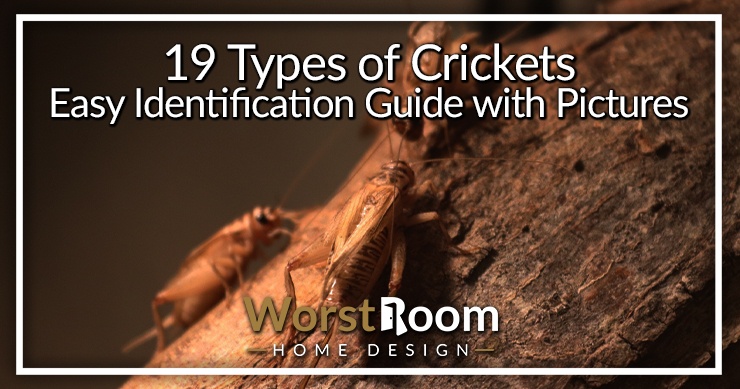
All of the various types of crickets are fascinating creatures despite being common insects. They have earned a lot of bad reputation for keeping people up all night. However, not all people consider them a nuisance. Some people even think of crickets as lucky.
When we are asked to think of crickets, the first image that pops into our mind (besides the Jiminy Cricket version, of course) is of the brown-black house crickets that scare us all by flying out of random places. But there are more types of crickets than you might think.
The Gryllidae family houses around 2,400 categories of insects, of which crickets are one. And interestingly, only the male species of this family produce the distinctive chirping sound.
19 Types of Crickets
Here, you’ll learn all you need to know about various kinds of crickets. Continue reading if you are curious to learn more about these interesting bugs.
House Crickets
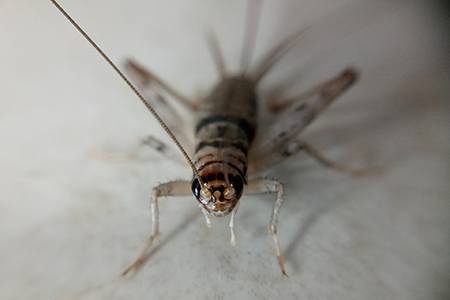
House crickets, as the name suggests, are the ones that can be found in your home. Their bodies are either light brown or grey, while their six legs are black. Typically, they span about 18 millimeters. But their most distinctive feature is the three dark bands on their head.
House crickets’ nymphs have the same appearance as the adults, except for their lack of wings. You’ll find them mostly taking shelter in your home during colder months due to their preference for warm and moist environments.
Look for them in the hotter areas of your house, like near the fireplace and heaters, in the kitchen, behind appliances and furniture, etc. Unfortunately, these bugs are nocturnal and become active and vocal at night, disrupting people's sleep.
Some nations consider them a delicacy with superior taste and texture and farm them. They are full of nutrients and can be included in a pet’s diet as well.
Camel Crickets
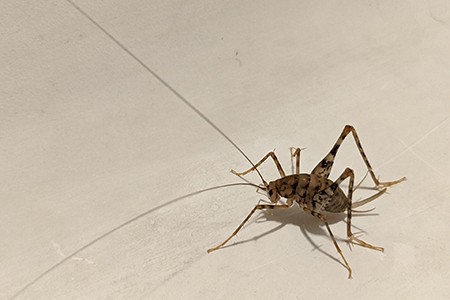
The arched hump-like back of this bug and its spidery thin legs resembles a camel, which is how these types of crickets got their name. Besides spider cricket and sand treader, they are also called cave crickets as they like damp and dark places like caves.
An interesting fact about camel crickets is that they are not actually crickets since they do not belong to the Gryllidae family. However, people categorize them as crickets because of their appearance.
Camel crickets can also be found near greenhouses and can be a menace if they somehow enter your home. You can identify them by their brown body with lighter spots. They are devoid of wings and instead jump long distances for locomotion.
Don’t let their long legs and antenna fool you into intimidation. Despite their tendency to eat through cardboard, wood, and your precious fabrics, these bugs are completely harmless.
Not to mention, they also leave a bad odor which can invite more unwelcomed pests. We recommend getting rid of them before they become a bigger problem.
Australian Field Crickets
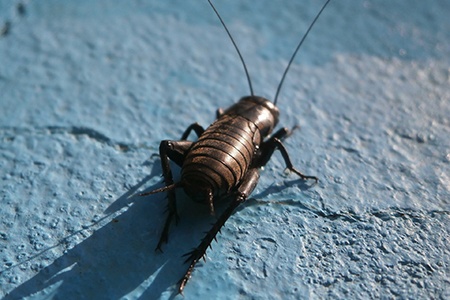
Teleogryllus oceanicus, otherwise known as the field cricket, have grown in number and spread out from Australia thanks to settlers and trade ships moving out from the region. They hopped on and took a ride, landed in places like Hawaii and started multiplying.
These types of crickets mature into a dark brown color but will have darker stripes on their backs and heads. These darker stripes are surrounded by thinner lighter stripes. Sometimes they're called Pacific crickets or Oceanic crickets.
Their song is created by them rapidly beating their wings. But even this isn't enough to attract the females, who don't always respond to the mating call. This has led to a high competition between the males of this cricket species, who will have a show of worthiness by wrestling with their antennae.
True Crickets
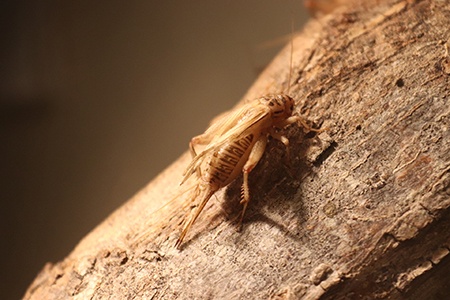
The true cricket types are called so because they're situated high in the Gryllidae family nearest to all types of grasshoppers and katydids. You'll know them by their wings laying flat against their also flat bodies, boasting relatively long antennae. Their size can vary, though.
Their coloration tends to be a light brown with darker spots along their wings, mouths, and at the joints of their larger rear legs. You may even detect an hint of orange colors if you look closely enough.
Tree Crickets
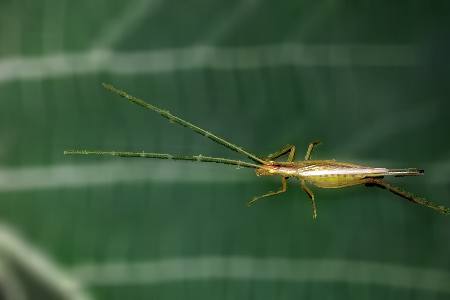
Perhaps the most visually interesting of the different kinds of crickets, tree crickets are such a very pale color we might as well call it white. Any other spots on them tend towards the color green but remain light as well.
These types of crickets are longer than other cricket species, coming in at 30 millimeters on average. Their length combined with how skinny they are makes them appear to be a bit spindly.
They use their wings to produce their chirping song, but unlike others they can actually fly with their wings. This helps them reach high spots in trees and bushes to escape predators.
During a process known as courtship feeding, these tree cricket types will secrete a nutritious fluid between and underneath their wings, which the female will consume during the mating ritual. This gives the male enough time to take care of his side of the business.
They sound more like cicada than other crickets, resembling a longer and continuous pitch, and the pitch and repetition rate of their song will change depending on the temperature. To pull this off they vibrate their entire wings instead of just part.
When you hear crickets on television, it's almost always a cricket species called the snowy tree cricket, which belongs in this category.
Katydid Crickets
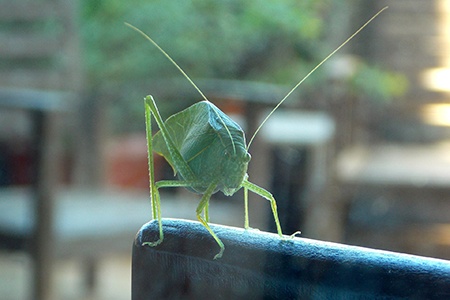
One could argue, correctly, that katydids aren't types of crickets, but for the sake of completion we should mention them so you know about them. In fact, in the USA many refer to these as bush crickets. Some call them long-horned grasshoppers, too.
The fact is they're from a different taxonomy, a different family called Tettigoniidae. You'll recognize them because they're bright green all over their bodies and their wings look like leaves. This camouflage helps them survive. They have extra long antennae that are very thin and whispy.
You can find them worldwide, due to their hardiness in dealing with climates and environments of all types. They can't fly despite having these large leaf-looking wings, because they don't have any hind wings to aid in flight. They can use them to flutter downward when leaping from trees.
Mole Cricket
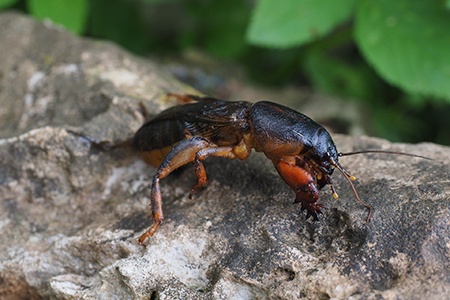
These types of crickets are interesting in that they resemble and behave like moles more so than they do crickets. They have two sets of wings, but the hind wings are insufficient for flight.
What they do have is fore limbs that look just like those of a mole that help them shovel soil around as they burrow underground. This behavior really damages crop yields on farms becasue they cause the soil to evaporate moisture faster.
They also end up disturbing rows of seeds and the root networks of seedlings that are trying to sprout. Some countries have developed ideas about them such as good luck, but in reality they're a pretty serious pest to agriculture.
Mormon Crickets
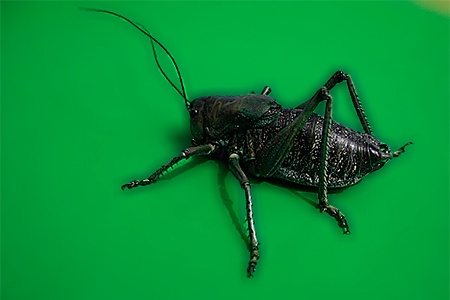
Despite their name, the Mormon Cricket belongs to the Tettigonidae family and are katydids instead. But they’re included as crickets because of their similar appearance.
These bugs have gotten their names because of their adverse history with the first Mormon settlement in Utah. As for their appearance has short wings with large bodies, and their size measures around 7 centimeters on average.
Mormon crickets are usually found in the western region of North America. They appear in purple, green, black, or brown and change their colors according to their swarming phase.
These crickets feed on crops, plants, and other insects, which disrupt the ecosystem as well cause devasting effects on agriculture. This was such the case for Mormons, who were already suffering from drought and had their food destroyed by these pesky little bugs.
Besides destroying the crops, the Mormon crickets also leave behind waste which stresses the farmers even more.
Once, these types of crickets were hunted and consumed by Native Americans, but they are now more popular amongst crows, coyotes, seagulls, and more.
The Jerusalem Crickets
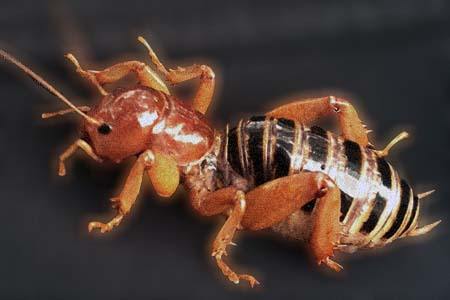
Another kind of cricket popular in western North America is Jerusalem cricket. They are also recognized as potato bugs or ‘old bald-headed men’ because of how they look. However, they are not really insects, nor are they bugs.
In fact, they do not feed on potatoes as well. You’ll be shocked to know that they don’t originate from Jerusalem either. In short, these creatures are nothing but imposters.
They have a smooth rounded body resembling a human head and a strong mandible. The latter is used to prey upon insects and decaying plants. Don’t try to provoke as they bite hard, but fortunately, it’s not venomous.
The worst feature of the Jerusalem crickets is their pungent odor, which they release to ward off any predator. They pair it with a large hissing noise and by rubbing their hind legs too. But at least they can’t do their trademark chirping. Instead, they create a pounding sound to attract mates.
Jerusalem crickets are burrowing creatures and use their feet to make their underground habitats. It is easy to identify them with their yellowish-brown body and black rings on their abdomen.
Field Crickets
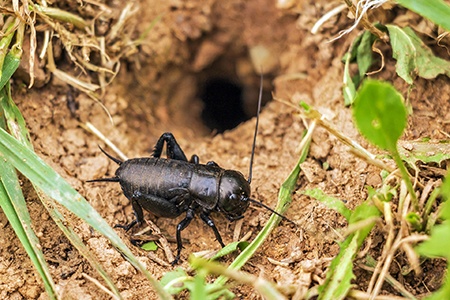
Field crickets have a small body, just slightly larger than house crickets. They even have the same black and brown body color with stripes on the back of their head.
This species also goes by other names because they are mostly found in Oceania and coastal Australia. You may have heard of them as Australian field cricket, Oceanic or Pacific cricket, and by their scientific title, Teleogryllus oceanicus.
By fluttering their wings, field crickets produce a song to attract suitable mates. However, the females often decline the mating call as they can be extremely picky. This, in turn, creates intense competition amongst the male suitors who fight to show their worth by pushing their antennas together.
And the ones that win let out a special victory call to prove their eligibility which draws in the females right away. If you want to distinguish these bugs by gender, you can do it by length.
The males of these types of crickets are shorter, about thirty millimeters, while females are slightly longer and can measure up to thirty-seven millimeters.
A variant of field crickets can also be found in Hawaii. Pure field crickets were bought into the state in trade ships and have since then altered their physiology after encountering a novel predator.
Parktown Prawn Crickets
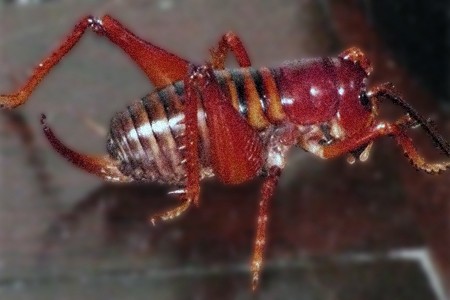
The name can be deceiving at first since these bugs are land species through and through. They are not crickets either but can be labeled as a close cousin group. Parktown prawn or African king cricket have been named after the South African neighborhood they have originated from.
They are about six centimeters long which makes them quite large compared to other crickets. Gardeners love having them in their various types of gardens due to their omnivorous diet.
If you want a living pest control, you can experiment with Parktown prawns as they have a healthy appetite for invertebrates like snails.
But never let them in your house because they will start chewing through your carpets and fabrics instantly. Not to mention, their fecal waste is a black liquid that smells and looks disgusting. But the worst part is that they can jump quite high and scare the living daylights out of you.
Roesel’s Bush Cricket
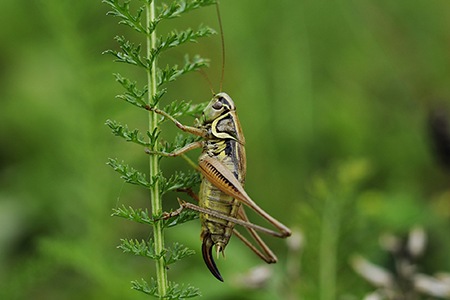
Crickets are also quite common in Europe, and one such kind is the Roesel’s bush cricket. Named after renowned entomologist August von Rosenhof, these bush crickets were first found in western Europe, extending up to western Siberia.
You’ll find these types of crickets in a variety of colors, but the yellow-green spots along their abdomen are a dead giveaway of their identity. And to find out their gender, just look for the females’ long sword-like ovipositors.
A tiny proportion of their species have fully formed wings, but they are barely functional to give flights. You’ll instead find them using their wings as a mating call.
Their songs are also quite distinct and resemble the high-pitched buzzing of electrical waves. Humans get extremely annoyed by it, especially since they never stop singing during warm weather.
Scaly Crickets
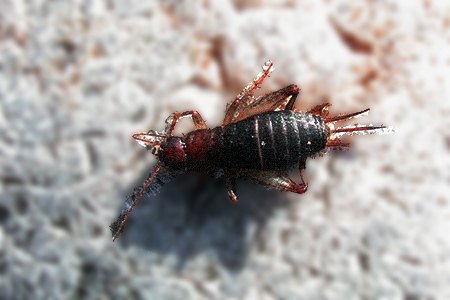
The Mogoplistidae family of crickets hosts the scaly cricket, which is comprised of 30 genera and 364 species across the globe. Twenty of these species across four separate genera can be find in North America.
They're fond of tropical environments that have access to water. They omnivores, meaning they'll eat whatever they can scavenge like plants, other insects, and fungi.
They have scales that cover their thorax and abdomens, which is where they get their name. A guy named Brunner von Wattenwyl thought he discovered them in 1873, but it turned out Serville described them in 1838 earlier.
Sword-Tail Crickets
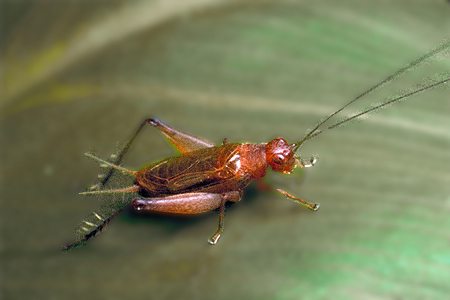
From the Trigonidiinae subfamily comes the sword-tail cricket, also known as the winged bush cricket or "trigs". There are dozens of species of crickets in this group, such as the Trigonidium cicindeloides. They have various looks to them, but they all tend to feature really long and upright antennae.
Wood Crickets & Ground Crickets
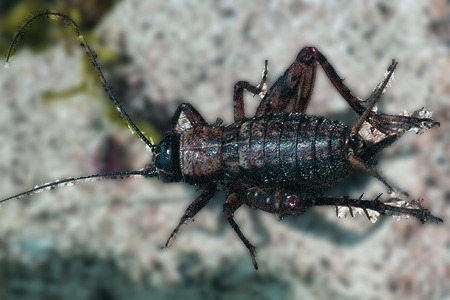
Sometimes known as pygmy field crickets, Nemobius sylvestris is a flightless cricket of the Nemobiinae subfamily found in Western Europe and North Africa. Despite this, it's rare to find these types of crickets in Britain for some reason.
They're small (about 1 centimeter in length), live on the ground, and have a dark brown color. They have relatively long antennae. They don't have hind wings, and in males the fore wings extend about half the distance down the length of the abdomen. The female's fore wings are just little nubs.
Their habitat consists of woodlands and forests. They prefer clearings and the edges of the woods, where they can enjoy leaf litter that's also receiving the warmth of the sun. They like to eat the fungus growing on decaying leaves. They also lay their eggs here.
Leaf-Rolling Crickets
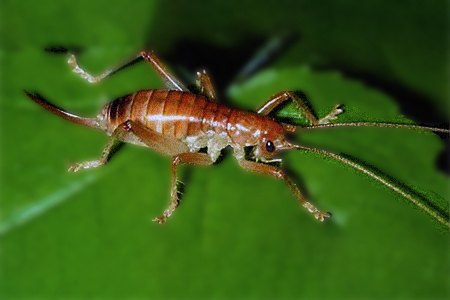
Sometimes called raspy crickets, this Gryllacrididae family is full of non-jumping bugs. The family contains the Gryllacridinae and Hyperbaeninae subfamilies.
These are wingless crickets that are nocturnal, which explains why you and I have probably not seen one. They do have a worldwide distribution. What they do is roll leaves up and sew them shut with silk, and hide in there all day.
There are some cricket species in this crew that will burrow in wood, soil, or sand, too. The fact that they can spin silk has nothing to do with other types of insects. They evolved that ability on their own.
Ant Crickets
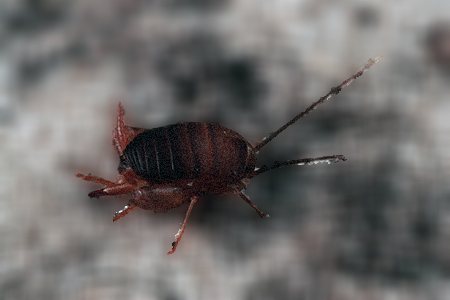
We call these ant crickets but a better name is ant-loving crickets. They're relatives to the mole cricket but are very rarely seen by your average person. Their scientific name is Myrmecophilidae.
These guys are obligate inquilines, meaning you can find them living in the nest of a different creature altogether. In this case, these crickets will live within the nests of ants.
These cricket varieties number up to 100 species but are all pretty similar. They could be mistaken for cockroach nymphs in appearance, being small, flat, brown, and wingless. They don't produce any sound since they don't have wings.
Cave Crickets
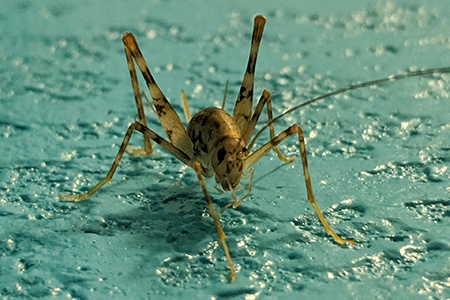
The Rhaphidophoridae family of the suborder Ensifera has spread its crickets across the entire world. That's why they have various names associated with them like land shrimp, sand treaders, and cave weta.
These types of crickets have large, powerful hind legs, including thick femora (thighs) and long, narrow tiibiae. They have really long antennae, too, that spawn from one region on the front of the head.
You've likely found these in your damp basement or crawling out of a shower drain, though they're largely found in caves and abandoned mines. If you turn over or look into a rotten log in the forest you may find one. They even can live near permanent ice in alpine regions!
They're brown, wingless, and can grow up to 2 inches in length. In their youth they can take on a translucent look, which always grosses me out because you can see their organs.
Dune Crickets & Splay-Footed Crickets
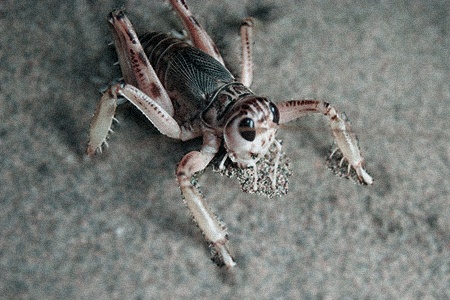
The Schizodactylidae family of orthopteran insects contain the dune crickets and splay-footed crickets. By looking at the image above you can absolutely see how someone came up with this species of crickets' name.
Found in in the desert areas and sandy regions of Asia and Africa, these crickets are predators. T. B. Fletcher, an English entomologist captured one and noted that despite ongoing observation, he never witnessed or found evidence that the dune cricket ever fed on the provided vegetation!
This family has two subfamilies that contain 16 cricket species total, discovered as early as 1773 and as recently as 2018.
Types of Crickets Around the World
Crickets may sometimes cause a nuisance, but they can also be deeply misunderstood like other insects. Hopefully, you can now identify the different types of crickets right away. So, the next time, you’ll be all ready to act at first sight of infestation.
You'll Also Enjoy:
- Natural Spider Repellent: 9 Safe Spider Deterrents for Your Home & Yard
- How to Get Rid of Fungus Gnats - Quickly & Permanently
- Where Do Spider Mites Come From? (Prevention Tips & More)
- Maggots in Compost: Good or Bad? Here's What to Do
- 14 Plants That Repel Spiders Indoors & Outdoors With Little Effort



